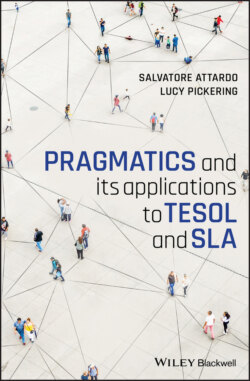Читать книгу Pragmatics and its Applications to TESOL and SLA - Salvatore Attardo - Страница 41
3.1.5 Indirect Speech Acts
ОглавлениеThe analysis of speech acts discussed earlier has a significant gap: it is possible to perform a given speech act by performing a different one instead. Recall that speech acts need not be linguistic, so it should not surprise us to find that one can perform more than one speech act at a time. Searle explains this as an “indirect speech act.” Consider the simple example:
(14) Can you pass the salt?
literally this is a question concerning the capacity of H to perform an action (passing the salt). However, the illocutionary force of the utterance is that of a request to pass the salt. Simplifying a little we have two paraphrases for (14) depending whether we look at the conventional meaning (sentence) or at the meaning in the situation (utterance).
(15) Are you able to pass the salt? (sentence force = question)
(16) Please pass the salt. (utterance force = request)
Searle argues that four components are needed to explain indirect speech acts
1 the theory of speech acts
2 the cooperative principle (see Chapter 4)
3 mutually shared background information
4 an ability to make inferences (1979, p. 32).
This is particularly significant because often the last two components are ignored.
Searle thus explains indirect speech acts by arguing that S performs one speech act at the sentence level, but using the principle of cooperation produces an inferential path whereby H can reconstruct another speech act, relying of course also on the mutually shared background of knowledge that S and H share, thus performing another speech act at the utterance level. Searle notes that the conclusion (i.e., the indirect speech act performance) is always “probabilistic” (1979, p. 35). This is due to the fact that all inferences based on the cooperative principle (implicatures) are probabilistic, as we will see.
Searle identifies some general classes of indirect speech acts. Thus, for example, one can perform an indirect request by asking whether a preparatory condition (see Section 2.1) for the speech act obtains. This is the case of passing the salt, if you cannot pass the salt, say because the salt shaker is out of your reach on the other side of the table, then I cannot properly request you to pass it. Conversely, if the salt is within your reach, and no other impediments exist, then by asking whether you can perform the action I indirectly ask you to perform the action. Another example is performing a directive by stating or asking whether the propositional content holds, for example,
(17) Will you stop making that noise?
where literally, at the sentence level S is merely asking whether H will or will not continue to make the noise in question, but at the utterance level, S is telling (i.e., directing) H to stop.
Indirect speech acts tend to conventionalize, which is why different languages have different ways of asking indirectly, for example. Once the forms have become idiomatic, they are preferred by the requirement to speak idiomatically (Searle, 1979, p. 50). Finally, Searle observes that the driving force for indirectness is the desire to be polite (p. 48).
Some recent research on indirect speech acts has gone in the general direction of the field (see Chapters 7–8 and 10–11), that is, toward more attention to the context of the performance of the speech acts. For example, in Mey’s (2001) idea of the pragmeme, that is, a speech act in context, in which the “interpretation” of the situation is based not just on the speech acts performed and the social negotiation of meaning but also on the situation and its affordances, that is, the interpretations/readings it favors. The idea has attracted some attention (e.g., Allan et al., 2016).
